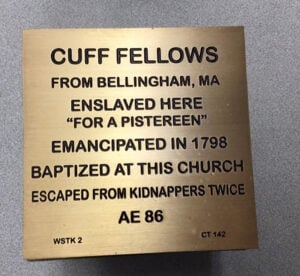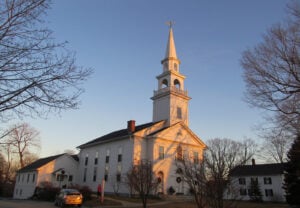I read two stories of interest in a recent issue of The Woodstock Villager, a local newspaper from my grandfather’s Connecticut hometown. The first story (on page A3) concerned a Witness Stone for Cuff Fellows (1762-1848), who spent half of his life enslaved in Woodstock. The marker was placed at the First Congregational Church (where my grandfather was baptized, where he married his wife, and where both were buried in the nearby cemetery along with several generations of my ancestors, and, maybe someday, myself). The article notes that Cuff Fellows was enslaved by Isaac Fellows and emancipated in 1798 by Isaac’s widow Leah (Paine) Fellows. Leah was the daughter of Daniel and Leah (Paine) Smith of Woodstock, the great-great-grandparents of my great-great-granduncle (by marriage) Lt. John Merrick Paine (1845-1916), who had served in the 29th Connecticut Colored Infantry Regiment during the Civil War.
 The second story (on page A9), concerned Rufus C. Malbone (ca. 1824-1884) of Putnam, Connecticut (my own hometown), an African-American farmer and laborer. He was buried beside his horse Dolly, who was shot and buried thirteen days after his death, with her inscription on the same monument reading “Dolly his faithful horse October 25, 1884.” This is certainly the first time I have encountered a horse and a human listed on the same grave marker.
The second story (on page A9), concerned Rufus C. Malbone (ca. 1824-1884) of Putnam, Connecticut (my own hometown), an African-American farmer and laborer. He was buried beside his horse Dolly, who was shot and buried thirteen days after his death, with her inscription on the same monument reading “Dolly his faithful horse October 25, 1884.” This is certainly the first time I have encountered a horse and a human listed on the same grave marker.
Rufus’s surname very likely derives from his parents or grandparents being enslaved by Godfrey Malbone (1724-1785) of Newport, Rhode Island, and Brooklyn, Connecticut, a wealthy enslaver and Loyalist of the area. Cuff Fellows’s wife Dinah was also enslaved by the Malbone family, as were ancestors of Albert E. Malbone (ca. 1844-1888) of Brooklyn, a soldier in the 29th Connecticut that I had previously researched and who has numerous descendants in northeast Connecticut today. I started to research both Cuff and Dinah Fellows, as well as Rufus C. Malbone, but was ultimately sidetracked by an intriguing note in the 1820 census of Woodstock.
Looking at the federal censuses of Woodstock after Cuff’s emancipation in 1798, I found Cuff in Woodstock in 1800, 1830, and 1840, listed under the columns “all other free persons” or “free colored persons.” However, in the 1820 census, Cuff Fellows and his household were all enumerated in the columns meant for “Slaves.” Two households below Cuff Fellows, also in this same category, was Othello Malbone, who was mentioned in the article on Rufus Malbone as a possible kinsman. However, looking at the page in its entirety, it’s clear that the census enumerator was using their own handwritten 1820 census form which did not include the usual number of columns. On the official 1820 census form, the first eleven columns concerned free white males and females, then four columns relating to foreigners and persons engaged in certain businesses, then eight columns concerning “Slaves,” followed by eight columns for “Free Colored Persons.” The 1820 census of Woodstock is 22 pages, with the first 21 pages for the free white population of the town. At the end of page 21 starts three non-white households, followed by 19 more on the last page. While these should be the columns for enslaved people, these were the last columns on the page and were clearly intended as the columns for “Free Colored Persons.” A note at the end of the page explains why the enumerator did not include columns for enslaved individuals in Woodstock:
 Above: “The only slave in Woodstock is a blind female negro aged 38 years at the house of Ebr Smith”
Above: “The only slave in Woodstock is a blind female negro aged 38 years at the house of Ebr Smith”
The Connecticut General Assembly passed the Gradual Abolition Act in 1784, which directed that all enslaved people born after 1 March 1784 would become free at the ages of 25 for men and 21 for women—it did not free their parents, or anyone born before that date. As the above woman was aged 38 in 1820, she was born about 1782/1783, and her enslavement not affected by this act.
Ebenezer Smith (1748-1825) is connected to my family in a few ways. He is my first cousin, seven times removed, via his maternal grandparents John and Abigail (Aspinwall) Child. Ebenezer was also the great-grandfather of Lt. John Merrick Paine, mentioned above.[1]
In the federal censuses, of 1790, 1800, and 1810, Ebenezer Smith’s household includes one enslaved person. In his 1821 will, he writes: “ Whereas I have a Servant Black Woman in my family Should she out live me and become expensive that my heirs should bear that expense Equally.”
Lt. John Merrick Paine’s brother, Lyman May Paine (1850-1939), later of Chicago, wrote a genealogy on his ancestors in 1914, A Memorial of John Paine and Mary Ann May of East Woodstock, Connecticut. Lyman mentions a few individuals enslaved by his ancestors, including a couple named Quash and Moll, who married in Barrington, Rhode Island in 1744 and are described on that record as “negro servants to the widow Smith.” (This last was Elizabeth (Holbrook) Smith, the paternal great-grandmother of Ebenezer Smith.) Later, Lyman Paine gives recollections about his visits to the Smith homestead, writing, “I particularly remember blind Jinny or Jin (probably Virginia) an aged negro woman, a former servant, perhaps a descendant of Quash and Moll, cared for and cherished as a member of the family with no thought of sending her to the poor house in her age and helplessness.”
Now that I had her name, I found her birth in the Woodstock Vital Records:
Gin was born only ten months too early to be included in the Gradual Abolition Act of 1784. Knowing that Gin was alive during Lyman’s childhood in the 1850s, I was able to find “Jenny Smith,” aged 68, in the 1850 census, living in the household of the 73-year-old Sarah (Perry) Smith, the widow of Ebenezer’s eldest child Charles Smith (1773-1848). Next, I found the 1845 will of Charles Smith, which included the following item:
“Whereas a servant woman (colored) was left by my Father to his heirs and I as one of the s d heirs am liable for two ninths of her support I therefore will that my three children to wit Charles D. Smith Mary Ann Adams and Esther Smith do give and render the above mentioned support to said colored servant woman.”
This language indicates that Gin/Jenny Smith was still legally enslaved at the time of Charles Smith’s 1845 will. This also meant that my great-great-granduncle, Lt. John Merrick Paine (1845-1916), who served as an officer in the United States Colored Troops during the Civil War, knew a woman in his childhood who was enslaved by his family.
Connecticut did not officially end slavery until 1848, emancipating approximately six remaining enslaved people who were born before 1784. Articles have suggested the last surviving enslaved person living in Connecticut was Nancy Toney of Windsor, who died in 1857. With Jenny Smith among those six freed by the 1848 legislation, and still alive in 1850, I was even more interested in finding information about her final years.
Jenny Smith died of heart disease at Woodstock on 8 July 1855, aged 72 years, the last person enslaved in Woodstock and one of the last remaining in Connecticut. I have not found any newspaper accounts of her death, but now her full name, lifespan, and additional details can be remembered with this article.
Note
[1] John and Abigail (Aspinwall) Child were the subject of my first article in the Register, “The Parentage of Sarah Child (1724-1805), Wife of Jedidiah Morse of Woodstock, Connecticut, and Other Bicknell, Child, and Morse Corrections,” Register , 159 (2005):317-324. Sarah Child (daughter of John and Abigail) and her husband Jedidiah Morse were the paternal grandparents of the inventor and painter Samuel F. B. Morse (1791-1872).
Share this:
About Christopher C. Child
Chris Child has worked for various departments at NEHGS since 1997 and became a full-time employee in July 2003. He has been a member of NEHGS since the age of eleven. He has written several articles in American Ancestors, The New England Historical and Genealogical Register, and The Mayflower Descendant. He is the co-editor of The Ancestry of Catherine Middleton (NEHGS, 2011), co-author of The Descendants of Judge John Lowell of Newburyport, Massachusetts (Newbury Street Press, 2011) and Ancestors and Descendants of George Rufus and Alice Nelson Pratt (Newbury Street Press, 2013), and author of The Nelson Family of Rowley, Massachusetts (Newbury Street Press, 2014). Chris holds a B.A. in history from Drew University in Madison, New Jersey.View all posts by Christopher C. Child →
